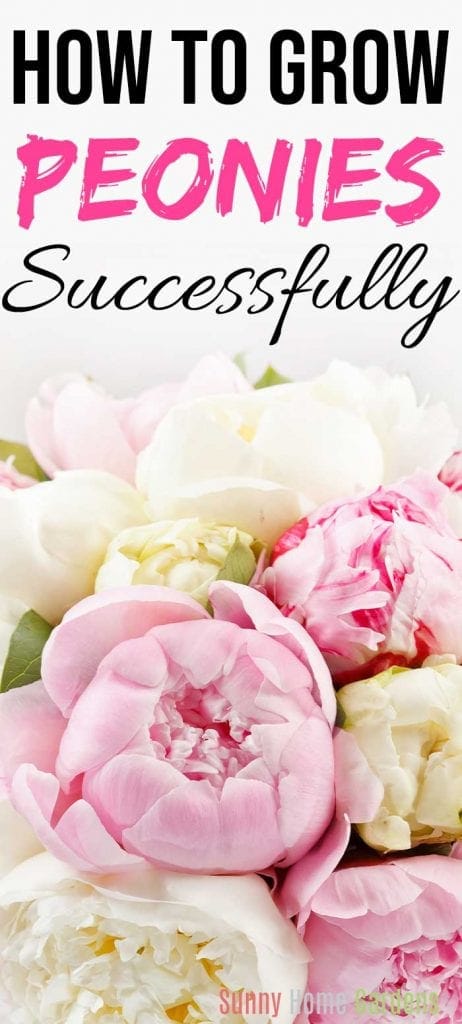Wanting to grow peony flowers? Learn all about how to grow peonies as well as peony care in this guide.
Peony flowers are so beautiful! Bonus – most of the varieties are fragrant and smell wonderful!
Peonies are a rather hardy plant. In fact, they typically live for at least 70 years. However, hardiness aside, you must know how to grow peonies to ensure you enjoy healthy, bloom-filled plants.
For instance, understanding how proper watering, soil content, and sunlight all work together will help ensure your peonies develop a strong root system that will support a long and healthy lifespan.
Once established in your yard peonies be prepared for your peonies to live a long time, maybe even outliving you. Some peonies are known to have lived over 100 years!
Peonies are so beautiful and fragrant, they are perfect for placing in vases around your home.
Luckily, this growing peony guide will help you know how to grow peonies as well as how to take care of them and other vital info, so you can have success growing these beautiful, fragrant flowers easily!
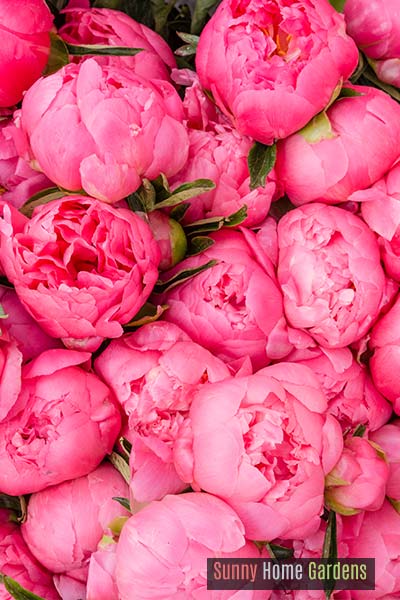
Table of Contents
Choosing Planting Location
Make sure the location you choose to plant your peonies in is one that has the best growing conditions for these beautiful plants.
Sun Requirements
Getting the proper amount of sun is not the only requirement for growing beautiful peony plants, but it is one of the most important ones when learning how to grow peonies.
For instance, a peony that does not get enough sunlight will experience stunted growth. Lack of proper sun will also result in peonies that do not bloom regularly.
Finally, if your peonies do bloom, the flowers will most likely be rather small.
To avoid these unwanted effects, you should be sure to plant your peonies in a location that enjoys at least six hours of sunlight each day.
Peonies need at least 6 hours of direct sun.
For best results, you should choose a spot that provides direct sunlight throughout the day.
Soil Requirements
Peony plants thrive in well-drained soil. Poor drainage can cause your plant to become waterlogged. A waterlogged peony will experience root rot, which will ultimately kill your plant.
Although peonies are extremely adaptable, they prefer a slightly acidic soil that ranges between 6.5 pH to 7.0 pH.
If your soil leans more towards a clay, you can simply add compost that includes phosphorus and nitrogen.
Planting Peonies
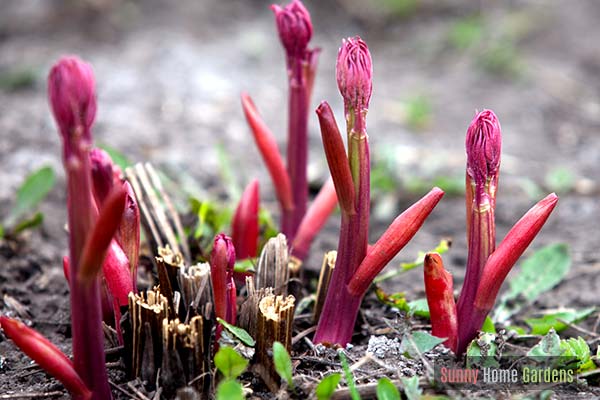
When to Plant Peonies
It’s better to plant peonies in the fall instead of the spring. The fall is also the time you want to divide or transplant peonies.
They should be planted about 6 weeks before the ground freezes in your area.
Planting Peony
In general, there are two types of peonies, tree and herbaceous peonies.
Tree peonies develop permanent stems that lose their leaves in the winter and remain above ground. Conversely, herbaceous peonies die back to ground level every fall.
You can either transplant your peonies or plant bare-root peonies. Bare roots are dormant. Additionally, they do not have soil around their roots, hence the name.
Herbaceous
First, dig a hole approximately 12 to 18 inches deep.
Then, using a garden fork, you can loosen the soil on the sides of the hole.
Following this, add a shovelful of compost followed by a handful of granular fertilizer. All-purpose, organic fertilizer is recommended.
Finally, you should top this off with a shovel of your original soil.
If you are planting a bare root, you should arrange the amended soil into a cone shape.
Next, place the peony on top of the cone so that the roots are hanging down the sides of the cone. Be sure to position the tallest bud no deeper than two inches from the surface of the soil.
Positioning any deeper will seriously hinder the number of blooms the plant will produce.
Tree peonies
Tree peonies do well in sunny or semi-shaded areas that do not receive morning sun and are protected from strong winds.
For a bare root, you can determine the proper depth of your hole by simply looking at the base of the stem.
For instance, you should locate where the stem was grafted to the root stock, a point that will have a bulge-like appearance.
Next, you should dig your hole such that the graft can be planted approximately four to six inches below the surface.
Prepare the soil by mixing the original soil with your compost.
Finally, fill in the hole with your dirt and compost mix. Whether you are transplanting or planting a bare-root, it is okay if most of your peony is below the soil as long as a few stems with buds remain visible
Care of Peonies
Watering
A vital part of peony care includes proper watering.
For instance, you should thoroughly water peonies that are newly planted or transplanted.
Additionally, be sure to allow the soil to dry out almost completely between watering.
Over the first year, you should water your peony every few weeks during dry weather. However, you will not need to water during wetter seasons, such as fall and winter.
As your peonies age, they will be pretty drought resistant. However, you should be sure to give them a good watering now and then throughout the summer.
Fertilizer
While some people choose not to fertilize, many do fertilize their peonies annually while others fertilize their peonies only after they bloom.
If you chose to fertilize as part of your care routine, you can use one-quarter cup of 10-20-20 fertilizer. Once spring hits, place the fertilizer around the drip line of your mature peonies.
For potted peonies, you should be sure to use a slow-release fertilizer. Anything other than slow-release can burn the foliage.
Pruning Peonies
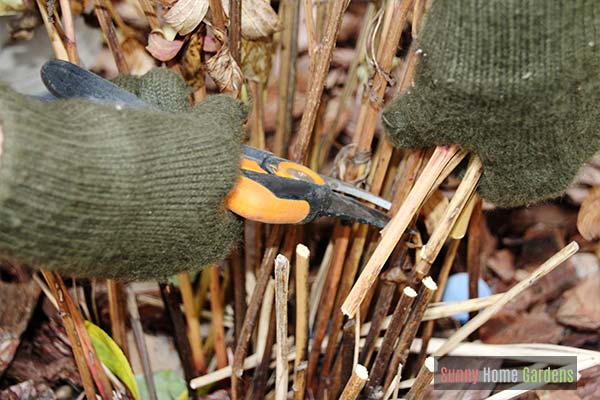
Although you will not often need to, there are a couple of instances that require pruning.
For example, if your plant is damaged or has a disease, you will need to prune the affected area immediately.
Additionally, when your peony is about five or six years old, it is recommended you remove the suckers located in the center of the plant to allow for proper circulation.
However, you can trim your peony stems in order to shape the way your plant grows. In terms of peony care, it is very important that you do not cut towards the bottom of the stem.
Peony stems grow slowly. Therefore, maintaining as much of the stem as possible is required for your peonies to grow properly.
Pests & Diseases to Watch For
Fortunately, peonies do not typically suffer from pests and diseases.
However, they are susceptible to gray mold and fungal disease. In fact, they are vulnerable to botrytis.
A weak peony is particularly susceptible. Additionally, cold, wet weather can increase the risk.
Signs to look for include blackened stems and buds.
You may also see rotting at the plant’s base. It is important to immediately cut off and throw out any infected areas.
Harvesting & Storage
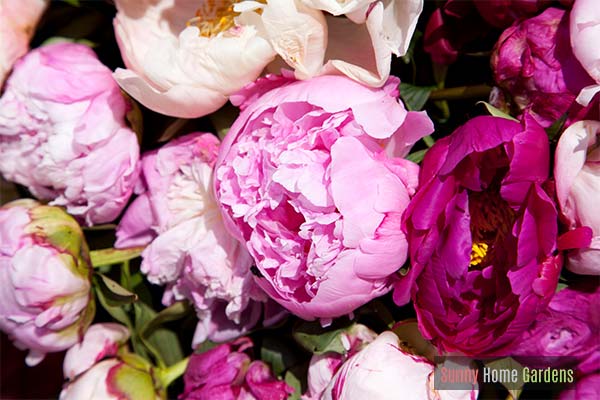
The best time to pick peonies is in the morning before the sun warms them. You should be sure to include at least 14 to 16 inches of the stem and remove any excess foliage.
Placing the cut flowers and buds in a location that is cool and dry will help prevent any fungal disease from developing.
Additionally, cut herbaceous buds that are immediately stored in a refrigerator will keep for several weeks. For best results, you should store them in bunches of 10 or fewer.
To ensure they receive proper circulation, you should wrap them in dry newspaper, ensuring the buds are covered and the cut stems are left open. Additionally, you should make sure to lay them horizontally to avoid damaging the stems. Finally, you should check the newspaper to ensure it remains dry.
Tips & Tricks For Beautiful Peonies
Spacing
There are no strict rules about spacing. It really depends on how you want your peonies to look.
For instance, for bushier peonies, you should plant them three to four feet apart.
For a hedge, you should plant them within two to three feet of each other. However, it is important to allow enough air flow. If they are planted too close together, they will be susceptible to botrytis and gray mold.
Dividing
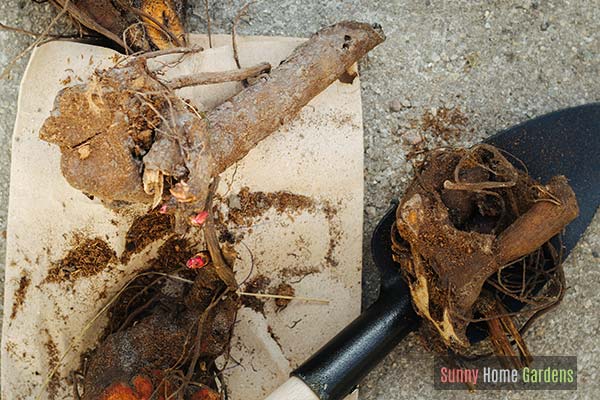
Although it is possible to divide peonies, it is important to note that once divided, peonies can take up to three years to bloom again.
You should use a sharp knife to successfully divide your peonies.
Additionally, you should make sure the sections contain at least three buds and plant the divided peonies immediately.
Ants
There is no need to worry if your peonies have ants. They will not harm the flowers. In fact, they are simply enjoying the surgery syrup the buds produce.
If you want to cut some flowers, just run them under cool water to wash the ants off.
Mulching
If you live in a place with cold winters and want to add mulch, you should be sure to remove it in the spring.
Otherwise, your peony will actually be planted too deep, resulting in fewer blooms.
If you found this post helpful, I’d love for you to “PIN IT“!
